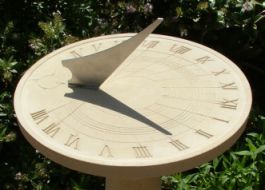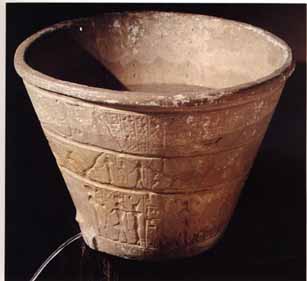 HISTORY OF TIME
HISTORY OF TIME 
The Hour
The Egyptians had ten hours of daylight from sunrise to sunset (exemplified by a sundial described in 1300 B.C.E.), two hours of twilight and twelve hours of night.
The calendar year was divided into 36 decans, each ten days long, plus five extra days, for a 365-day year. Each decan corresponded to a third of a zodiacal sign and was represented by a decanal constellation.
In the summer sky the night corresponded to about twelve decans, although half a day would correspond to eighteen decans. This led to the division of the night into twelve hours.
The first hours were seasonal in that their length varied with the season. (Note that this system was also used in oriental clocks.) Later, Hellenistic astronomers introduced equinoctal hours of equal length.
The Minute and Second
The Babylonians (about 300-100 B.C.E.) did their astronomical calculations in the sexagesimal (base-60) system. This was extremely convenient for simplifying division, since 60 is divisible by 2, 3, 4, 5, 6, and 10. The first fractional sexagesimal place we now call a minute, the second place, a second.
SUNDIALS

Sundials were one the earliest forms of telling time. One of the first ancient people to use sundials were the Sumerians. Sundials contains 3 parts: a circular dial, a needle and a style (gnomon) to keep the needle in place. They divide the day into 12 parts and each part is about 2 hours long. They measure the length of shadows to determine how much time has passed. No one is really sure why the Sumerians kept track of time; maybe it was for religious purposes.
EGYPTIANS
The Egyptians also divided the day into 12 parts. They used huge granite columns called Cleopatra Needles to keep track of time periods. They had 12 marks on the ground that equalled 12 parts of the day. When the sun touched the top, a shadow was created and the length and position of the shadow told the Egyptians how much daylight remained. .
ROMANS
The Romans divided time into night and day. According to the writer Pliny, criers announced the rising/setting of the sun. In 30 B.C, they stole Cleopatra's needle but were unable to adapt. A man named Al-Battani knew something that the Romans didn't: the gnomon had to point towards the North Star and the length and size of the gnomon varied with the distance from the equator.
PROBLEMS: Cleopatra's needles were inconvient and impractical for the average person. Sundials were also dependent on the weather; it would be useless on a cloudy day and the winter and summer shadows would not correspond with the markings. And in order for the sundial to work correctly, it had to be positioned correctly.
WATER CLOCKS

The need to track night hours lead to the invention of the water clock. It was basically a bucket of water with a hole in the bottom. A water clock showed the passage of time but it didn't keep exact hours in a day. Egyptians were the ones most likely to have invented the water clock but the Greeks had the most advanced ones.
GREEKS
A Greek water clock was called a clepsydra meaning "water thief". It was a bowl with a hole in a bucket of water; the sinking of the bowl marked the passage of time. These clocks were used to time the speeches of lawyers in courts. As the water clocks became popular, they became more elaborate. They incorporated more bowls: when one ran out of water, another filled. In 250 B.C, Archimedes built a more elaborate water clock; he added gears and showed the planets and moon orbiting.
PROBLEMS: In order for a water clock to work properly, someone had to keep an eye on it; to make sure that no pebbles were in the bowl to increase talking time. These clocks were never exact; each clock had its own pace. And they couldn't be used in winter.
HOUR GLASS

An hour glass is basically 2 bubbles of glass with a narrow middle; wood is used to close off the sand. The sand is measured and sealed and the hour glass is turned over and over. This type of clock was the first one to not be dependent on the weather. It was used for short periods of time such as speeches, sermons, watch duty, cooking, and at sea to calculate one's position.
To calculate the speed at sea, one would throw a piece of wood overboard tied with a knotted rope. When a knot ran through one's fingers in 1/2 a minute measured by the hour glass, it indicated that the vessel was going at the speed of 1 nautical mile an hour. The knots were very wide apart and one just counted the knots. Hence the phrase "knots an hour".
PROBLEMS: The center of the hour glass would get clogged. Course sand wore away at the center and made the opening wider. An hour glass had to be on a flat surface in order to work properly.
MODERN CLOCKS
Modern clocks have three parts: a power source, a pace regulator and something that shows the time. The word 'clock' comes from the French word "cloche" meaning bell. The clock was developed 100-1300 A.D in Europe (although some say in China). The first clock used weights; gravity pulled weights which moved gears, which moved the gears which moved the hands. The problem with this device was someone had to constantly reset the weights.
Between 1300-1500 large clock towers were built. They were heard for miles around. The Strasbourg Cathedral was the first clock tower built (1352-54) and still works today. As Europe grew, each town had to find a way to tell time; there was an emphasis on productivity and work. In 1577 the minute hand was invented by Jost Burgi for Tycho Brahe; he was an astronomer who needed accurate clocks to track stars. By 1656, the pendulum was incorporated into clocks, which lead to better paced and more accurate clocks. In 1504 the first portable time piece was invented in Nuremberg, Germany by Peter Henlein. However, his watch was inaccurate, had no cover, was six inches high, made of iron, and ugly. It worked fine when left on a table but useless when carried
The Clock Doc
3534-34th St
Lubbock, TX 79410
(806)797-5036
Contact us at:

john@clockdoc.com
HISTORY OF TIME
HISTORY OF TIME


